




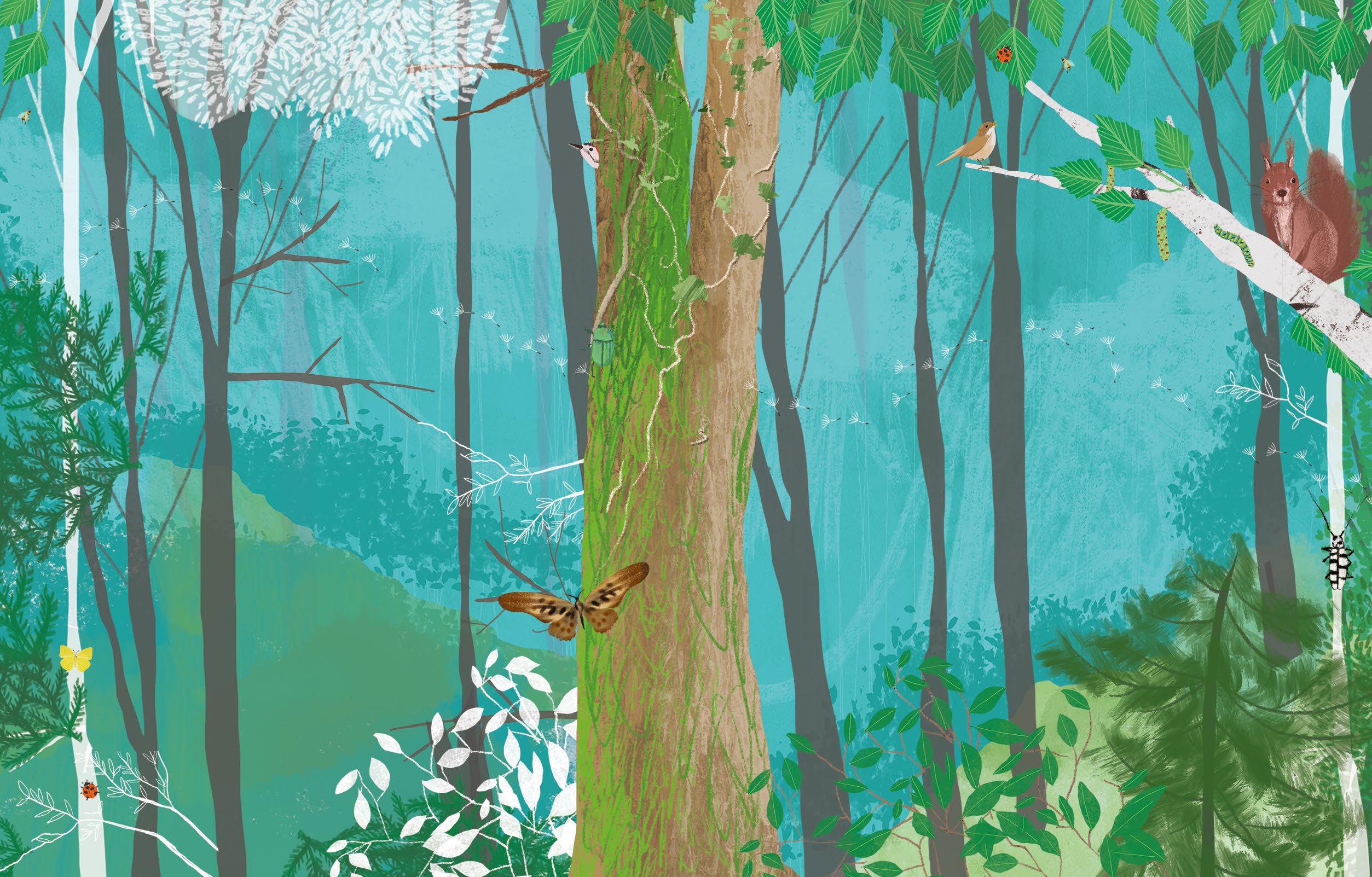
P. 12
WHAT ARE PLANTS MADE OF?
We’ll discover all the parts that make up trees and what they do.
30
THE LIVES OF TREES
We’ll discover how trees are “born,” how they reproduce, what they eat and drink, how they breathe, and even how they move, how they communicate, what makes them suffer, how they defend themselves and how they die.
48
We’ll discover which animals depend on trees, and which animals trees need to stay alive!

P. 56
PEOPLE
We’ll discover how trees have been essential to our lives since ancient times, and how to be respectful of them and protect them.

HOW OFTEN DO THE TREES ALL AROUND US, RIGHT IN FRONT OF OUR EYES, GO COMPLETELY UNNOTICED?
We're so used to being surrounded by these silent, unmoving friends that we sometimes forget that they’re living beings just like us: they’re “born,” they fight to grow, and they eat, breathe, and communicate. Plus, they're even able to move and forge solid friendships that can be quite surprising!
THANKS TO THIS BOOK, YOU’LL DISCOVER THAT THE LIVES OF TREES ARE MORE COMPLICATED THAN YOU MIGHT HAVE THOUGHT AND THAT THEY AREN’T SO DIFFERENT THAN OURS!


Browse the pages that follow in search of FUN FACTS and INCREDIBLE WORLD RECORDS.
When you come across especially complex scientific terms, don't worry! Just look for the GLOSSARY at the bottom of the page.
AQUATIC PLANTS
The history of plants begins billions of years ago: like many other organisms, they first appeared in the sea, in the form of algae made of up a single cell.
They then evolved into the vast, diverse species that we find today in every habitat on our planet.
TAKE A LOOK AT THE TIMELINE SHOWN HERE, GOING FROM LEFT TO RIGHT, TO DISCOVER SOME OF THE MOST IMPORTANT STEPS IN THE HISTORY OF PLANT EVOLUTION.
Green algae are the ancestors of the plants that populate our planet, still present in different aquatic settings (lakes, rivers, lagoons, seas, etc.), where they can live as single cells or in colonies

PLANTS THAT GROW ON THE GROUND
Some of the first plants to grow outside of water, today moss species can be found in the coolest, most shaded zones of different habitats. To reproduce, they use tiny spores that are blown about by the wind.
They were the first plants to grow roots, trunks and leaves. They reproduce via spores, which are often gathered in small “buttons” on the underside of their leaves. They include ferns, Lycopodium and Equisetum. There are fewer of them and they're less developed than in the past, when they could grow to be many feet high, acting as nourishment for lots of animals, including dinosaurs!


MILLIONS OF YEARS AGO

They’re the first plants to have developed seeds, a fundamental revolution, because, thanks to those seeds, these plants could make do without water for their reproduction, necessary to moss and ferns. Today, gymnosperms include plants such as conifers (pines, firs, larches, etc.) and some small shrubs.

Dicotyledons and monocotyledons are part of a category of plants called angiosperms, also known as flowering plants. Compared to gymnosperms, they produce flowers to attract insects and fruit to hold their seeds. Flower and fruit serve to be more successful in reproduction as they can be dispersed more effectively.


MILLIONS OF YEARS AGO
A BIOME is a vast part of the world characterized by dominating plants and a certain climate that, interacting with each other, create a distinct, unique and balanced community.
STUDY THE MAP TO DISCOVER THE WORLD’S BIOMES AND THE MOST COMMON TREES WITHIN THEM.
FIR/SPRUCE
The main factor causing the loss of plant and animal biodiversity is HABITAT DESTRUCTION. It can be caused by natural disasters (eruptions, floods, fires, etc.) or by human intervention (pollution, deforestation, factory farming, etc.)
Biomes provide vital habitat for a variety of plants, animals and other organisms, but they also play an important role in maintaining the climatic and ecological balance of our planet.

 MAPLE
ACACIA
OAK
MAPLE
ACACIA
OAK
(OR BOREAL FORESTS)
TUNDRA
DESERT
MEDITERRANEAN VEGETATION
TEMPERATE DECIDUOUS FOREST
TROPICAL FOREST SAVANNA GRASSLAND

In polar regions, vegetation is scarce and is made up of moss, lichen and algae.

EVERY TYPE OF BIOME IS DETERMINED BY THE TYPE OF CLIMATE PRESENT IN A SPECIFIC AREA, WHICH IN TURN DETERMINES THE SPECIES WE MIGHT FIND IN EACH OF THEM.
Trees don’t grow in all biomes. They’re practically non-existent in the tundra, for example, and the vegetation there is mainly moss and lichen.
LET'S TAKE A CLOSER LOOK AT THE AREAS IN WHICH TREES CAN LIVE, AND DISCOVER THE CHARACTERISTICS OF THESE BIOMES.
ANNUAL RAINFALL MAXIMUM AND MINIMUM TEMPERATURE up to 394 in (10,000 mm)!
from 72° F (22° C) to 86° F (30° C)
• TROPICAL FORESTS
In the areas covered by tropical forests, the climate is warm and very rainy. The plants and trees here, which have not just light but also lots of water available all year round, grow quickly, giving rise to expansive forests rich in biodiversity.

• MEDITERRANEAN VEGETATION
Also called Mediterranean maquis, this sort of vegetation is found all around the Mediterranean basin, but as you can see on the map, it’s also found in other parts of the planet.
Warm and dry in summer and temperate in fall and winter, the climate facilitates the growth of vegetation constituted of trees and shrubs with hard leaves that can stand up to high temperatures.
from 41° F (5° C) to 104° F (40° C)
from 12 in (300 mm) to 39 in (1000 mm)

from -58° F (-50° C) to 50° F (10° C)
from 6 in (150 mm) to 24 in (600 mm)
Cold temperatures and snow are the stars of this biome most of the year. Despite these harsh conditions, you might still find large, expansive forests of conifers such as firs (classic Christmas trees!) and pines, but also birch trees.

• TEMPERATE DECIDUOUS FORESTS
This biome, which is found in areas with a temperate climate, is characterized by expansive forests of deciduous trees (which lose their leaves in winter), such as beech, maple, oak and linden trees, in which the seasonal cycle can thus be fully observed.
from -4° F (-20° C) to 95° F (35° C)
from 20 in (500 mm) to 47 in (1200 mm)

IF YOU WANT TO KNOW WHAT THE SEASONAL CYCLE IS, GO TO PAGE 28.
from 73° F (23° C) to 99° F (37° C)
from 39 in (1000 mm) to 59 in (1500 mm)
• SAVANNAS
Savannas are characterized by a dry season, without rain, and a wet season, during which it rains a lot. The most common trees are baobabs and acacias.

Even if no two trees are exactly alike, each type of foliage can be generalized into a few outlines and shapes, which can be made out from far away.
THESE ARE THE MAIN SHAPES OF TREE FOLIAGE AND CROWNS, BASED ON THE CHARACTERISTICS OF THEIR BRANCHES AND LEAVES.
Tree “bodies” include different organs, just like our bodies.
There are three main organs in any tree:
• CONICAL/ PYRAMID conifers
• COLUMNAR cypresses and some poplars
• OVAL southern magnolias
TRUNK CROWN
ROOTS
Their shape and purpose vary greatly depending on the species, with characteristics that can sometimes be very strange!

• ROUND many types of oaks
• UMBRELLA/ SPREADING stone pines
• WEEPING weeping willows
TO SURVIVE IN DIFFERENT CLIMATES, TREES HAVE LEARNED TO CHANGE THEIR SHAPE ACCORDING TO THE ENVIRONMENT.
In colder regions, for example, we often find trees that can stand up to freezing temperatures, but also those that shed their leaves before heading into long winters.
AND HOW HAVE TREES IN DRY REGIONS ADAPTED? KEEP READING TO LEARN ALL ABOUT THIS AND OTHER EXAMPLES OF ADAPTATION!

CYPRESS TREES AND OTHER SPECIES THAT LIVE IN WINDY AREAS
The trunk of this plant is made of a type of wood that's very durable, yet also flexible. The trunk, branches and leaves of this tree grow and bend depending on the way the wind blows.
These trees are found in dry environments and their trunk has transformed into a giant cylinder able to collect and store water. That makes it possible for baobab trees to survive, even during hot, dry African summers.

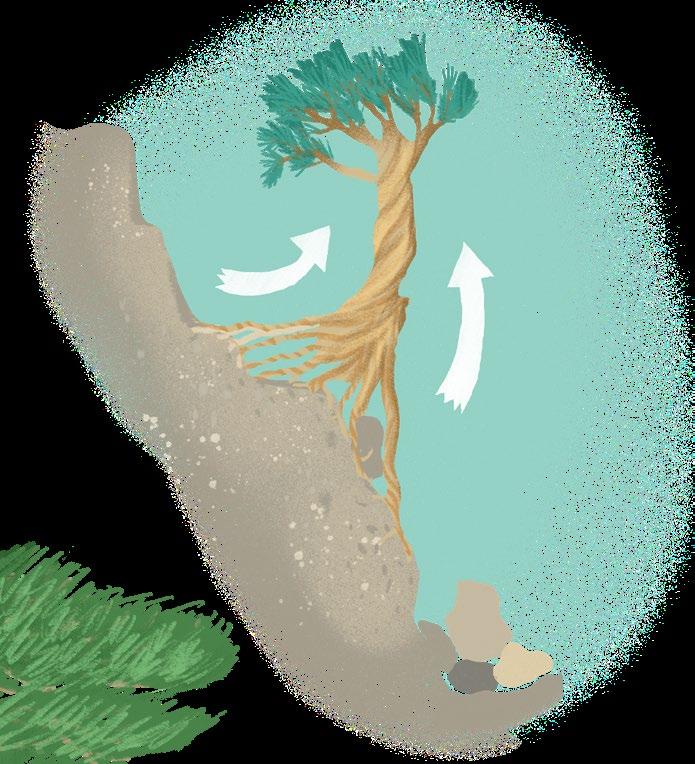
DRYIT! STORYOFTHEIRENVIRONMENT!
LIKE OUR HAIR,WHENWEBLOW

Sometimes, during a tree's lifetime, the surrounding environment changes. Imagine if you were stuck in one place forever: what could you do, for example, if a boulder fell next to you? You could grow around it!
When outside factors limit a tree's ability to grow vertically, it will be forced to twist as it grows. But, as soon as it gets the chance, it will start to grow vertically again.
Trees don’t grow in all biomes. They’re practically non-existent in the tundra, for example, and the vegetation there is mainly moss and lichen.
LET'S TAKE A CLOSER LOOK AT THE AREAS IN WHICH TREES CAN LIVE, AND DISCOVER THE CHARACTERISTICS OF THESE BIOMES.
ANNUAL RAINFALL MAXIMUM AND MINIMUM TEMPERATURE up to 394 in (10,000 mm)!
from 72° F (22° C) to 86° F (30° C)
• TROPICAL FORESTS
In the areas covered by tropical forests, the climate is warm and very rainy. The plants and trees here, which have not just light but also lots of water available all year round, grow quickly, giving rise to expansive forests rich in biodiversity.

• MEDITERRANEAN VEGETATION
Also called Mediterranean maquis, this sort of vegetation is found all around the Mediterranean basin, but as you can see on the map, it’s also found in other parts of the planet.
Warm and dry in summer and temperate in fall and winter, the climate facilitates the growth of vegetation constituted of trees and shrubs with hard leaves that can stand up to high temperatures.
from 41° F (5° C) to 104° F (40° C)
from 12 in (300 mm) to 39 in (1000 mm)

from -58° F (-50° C) to 50° F (10° C)
from 6 in (150 mm) to 24 in (600 mm)
Cold temperatures and snow are the stars of this biome most of the year. Despite these harsh conditions, you might still find large, expansive forests of conifers such as firs (classic Christmas trees!) and pines, but also birch trees.

• TEMPERATE DECIDUOUS FORESTS
This biome, which is found in areas with a temperate climate, is characterized by expansive forests of deciduous trees (which lose their leaves in winter), such as beech, maple, oak and linden trees, in which the seasonal cycle can thus be fully observed.
from -4° F (-20° C) to 95° F (35° C)
from 20 in (500 mm) to 47 in (1200 mm)

IF YOU WANT TO KNOW WHAT THE SEASONAL CYCLE IS, GO TO PAGE 28.
from 73° F (23° C) to 99° F (37° C)
from 39 in (1000 mm) to 59 in (1500 mm)
• SAVANNAS
Savannas are characterized by a dry season, without rain, and a wet season, during which it rains a lot. The most common trees are baobabs and acacias.

Within the varied world of trees, there is a lot of diversity, and every species has adopted the best strategies possible in order to survive. Evolution has led to such drastic changes so as to achieve world records in the plant world!

These trees are the biggest and heaviest on the planet. They live in California, where the make up immense forests.
WORLD’S SMALLEST TREE THE WORLD’S LARGEST TREE THE WORLD’S TALLEST TREE
The tallest known living tree in the world is called Hyperion. It’s a coast redwood (Sequoia sempervirens) in California.
Some sequoias are over 360 ft (110 m) tall...
This tree is truly tiny! A few leaves grow on its trunk, which reaches a height of just a few inches. Dwarf willows (Salix herbacea) lives near mountains, where it makes up expansive micro-forests!

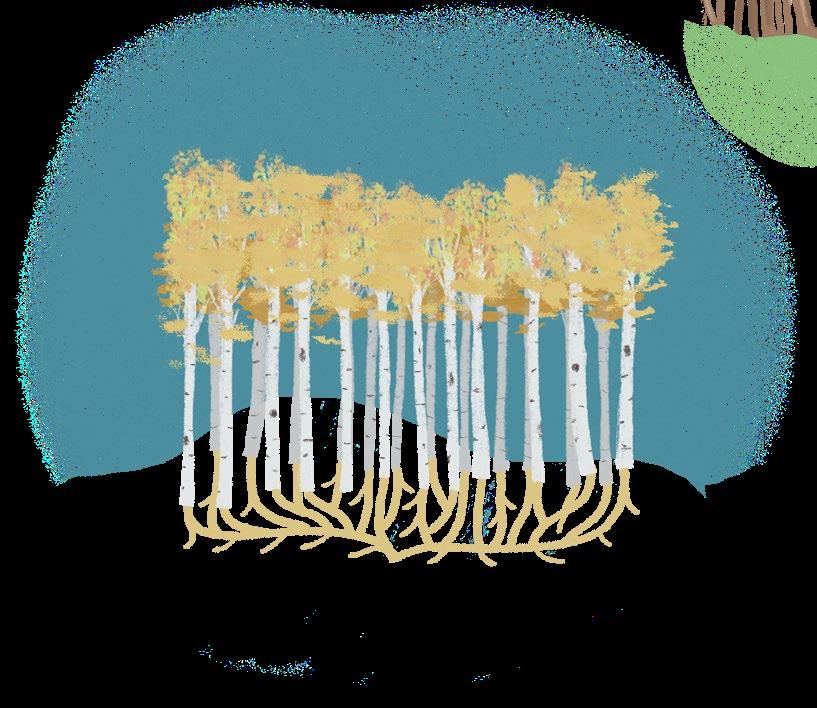

The world's oldest tree is over 5,000 years old! Even the leaves on this species are long-lived: it seems they can last up to 40 years!
IN SOME WAY, TIME DOESN’T GO BY
tree FOR THESE TREES!
The crown of the Banyan tree named ThimmammaMarrimanu, which is sacred to the people of India, covers more ground than two soccer stadiums! How did it manage to get so big without falling over?
SECONDARY TRUNKS GROW DOWNWARD FROM THE HORIZONTAL BRANCHES, HELPING TO SUPPORT THE CROWN.

AN ENTIRE FOREST MADE UP OF JUST ONE TREE!
Experts have discovered that, in the United States, there’s an entire forest that’s made of just one tree! It’s called “Pando.” How, you're wondering?
A SINGLE QUAKING ASPEN MANAGED TO GENERATE NOT JUST ONE, BUT MANY TRUNKS, UNTIL IT FORMED AN ENTIRE FOREST MADE UP OF THE SAME PLANT.
The part of the tree that we can’t see is probably the most important! Indeed, tree roots do three very fundamental things. They make it possible to anchor the tree firmly to the ground, so that it can grow upwards without falling, and they find and absorb water and nutrients from the soil. They also constitute a sensory organ, which provides very important information about the environment to the tree.

THANKS TO ITS ROOTS, THE TREE CAN SENSE WATER, WHICH IT THEN TRIES TO REACH!
The younger part of the roots is covered by special structures called root hairs. They extend into the ground, greatly increasing the surface of the roots and the ability of the tree to absorb nutrients and interact with other organisms, like fungi and animals underground.
ROOTS
CHANGE THE DIRECTION THEY GROW IN BOTH TO EXTEND TOWARDS WATER AND TO GO AROUND ROCKS THAT ARE IN THEIR WAY.
ROOT HAIRSROOT HAIRS MAKE IT POSSIBLE FOR THE TREE TO INTERACT WITH OTHER ORGANISMS.

HOW BIG ARE THE ROOTS OF A TREE? THEY CAN SOMETIMES TAKE UP A SPACE THAT'S EVEN BIGGER THAN THE TREE'S CROWN!
ARE ROOTS ALWAYS FOUND UNDERGROUND? NO! THERE ARE A FEW EXCEPTIONS!
TURN THE PAGE TO LEARN ABOUT THREE OF THEM!
Depending on the species, the climate and the surrounding environment, roots can change shape and even leave the ground!
HERE ARE THREE EXAMPLES OF ROOTS THAT DO REALLY STRANGE THINGS!
In some trees that grow in tropical areas, special roots grow from the branches. They are called “aerial” roots, and they latch on to their neighbors so that the tree can grow taller than them.
RECORD-BREAKING STRENGTH!
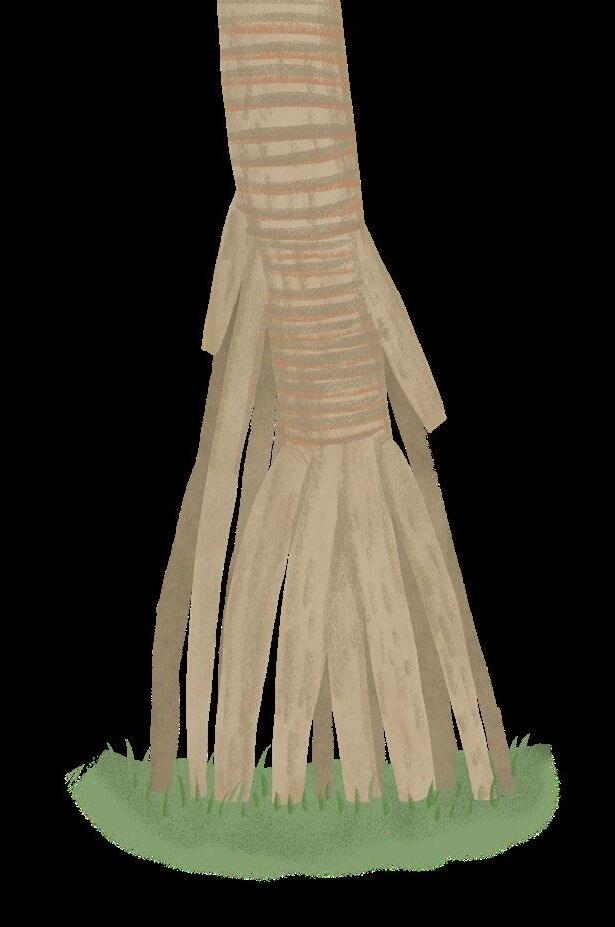
HAVE YOU EVER SEEN TREE ROOTS THAT BREAK THE PAVEMENT IN A CITY? HOW COULD A TREE DESTROY SUCH A HARD, TOUGH MATERIAL?

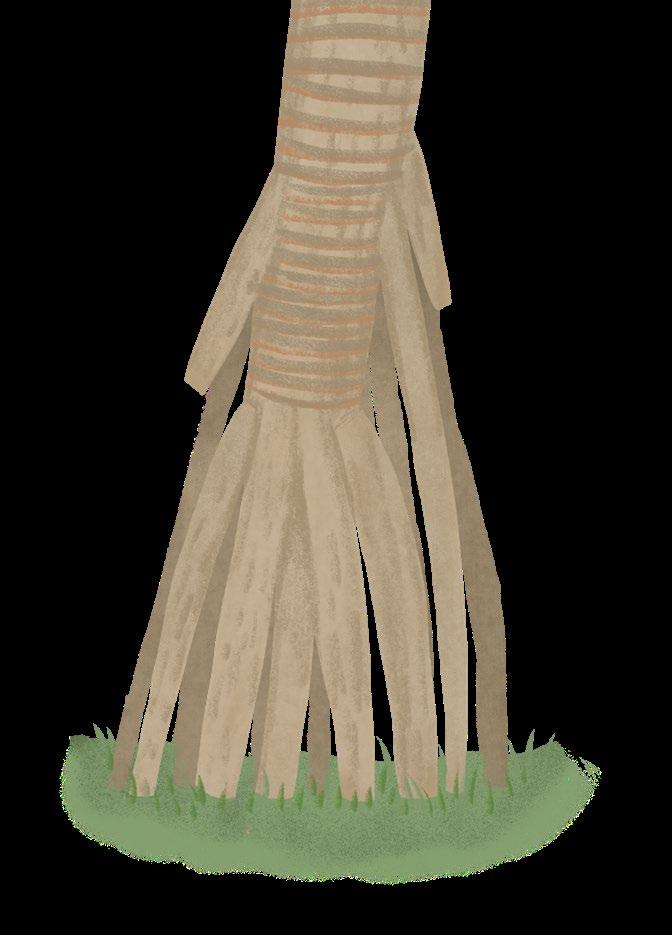
Roots will extend into any small space they can, in search of water and nutrients. Once they've “taken root,” they begin to grow in diameter, which is how, as time passes, they manage to break rocks, bend gates and even lift asphalt!
ROOTSAREREALLY STRONG!



UNDERWATER ROOTS
In mangrove forests, there are trees that live along the seashore, where they create forests floating above the water.
THESE SPECIAL ROOTS ANCHOR TREES TO THE GROUND WHILE OFTEN BEING ENTIRELY UNDERWATER DURING HIGH TIDE. THEY MAKE IT POSSIBLE FOR THE TREES TO SURVIVE EVEN IN SALTWATER.
MANGROVES ARE THE HABITAT OF MANY DIFFERENT ANIMALS, FROM FISH TO AMPHIBIANS, FROM REPTILES TO BIRDS.


The trunk is the part of the tree that grows upwards and which supports the branches and leaves. It’s also a conduit for the transportation of water and the nutrients absorbed and produced in every part of the plant. It works like a small freeway, made up of tiny channels through which the substances constantly circulate.
The trunk also stores the tree's reserves, which are to be used in times of hardship, such as in winter or in very hot summers.
If you look at a cross-section of a trunk, you’ll notice concentric rings made of wood, which is the tissue that transports water and minerals from the ground to the top of the tree. Each tree produces a ring, which is formed on the outer layer of the trunk, allowing it to grow not only in height, but also in width. By counting the rings of a trunk, you can discover how old a tree is. Try it on the opposite page!

This is the oldest part of the tree; it no longer transports water and minerals.
This is the young part of the tree, where xylem sap (from the roots to the leaves) and phloem sap (from the leaves to the roots) are exchanged.
COUNT THE RINGS OF THE TRUNK TO FIND OUT HOW OLD THIS TREE IS. THE ANSWER IS AT THE BOTTOM OF THE PAGE.
Tree trunks always have alternating thick and thin rings. The thick ring is wood which grew in spring, which is the time when the tree grows quickest, waking up after winter. The smaller ring, on the other hand, grows during late summer, almost in fall, when the tree is getting ready for the cold season.

COMBINED, THESE TWO RINGS CORRESPOND TO AN ENTIRE YEAR'S WORTH OF GROWTH. STUDYING THEM CAN REVEAL A LOT ABOUT THE LIFE OF THE PLANT: HOW OLD IT IS, HOW IT'S LIVED, IF IT'S GROWN A LOT OR IF IT'S HAD A HARD TIME SURVIVING.
DENDROCHRONOLOGY: the science of studying the age of trees, made up of Greek words: dendron = tree, and khronos = time.